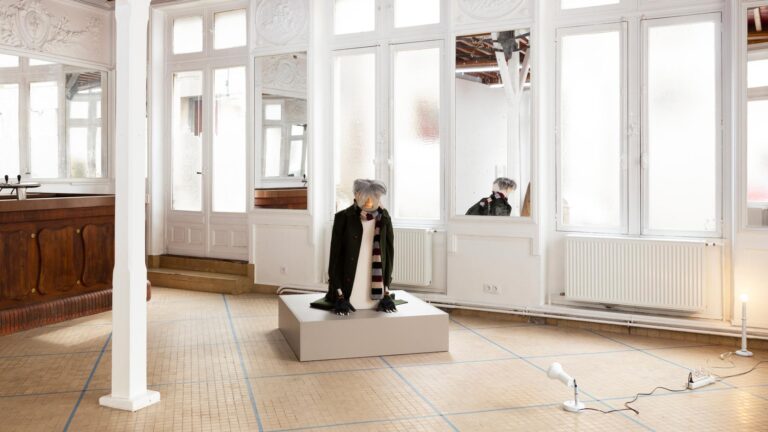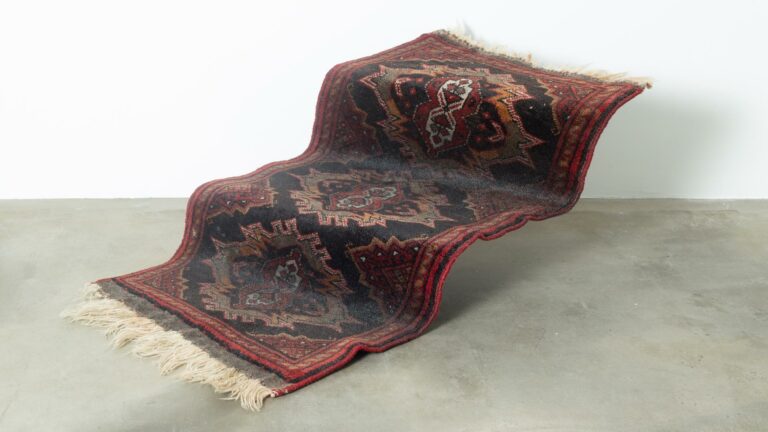Artists: Ali Cherri, Cao Fei, Cui Jie, LaToya Ruby Frazier, François-Xavier Gbré, Pauline Ghersi, Cecilia Granara, Tirdad Hashemi, Rayane Mcirdi, Marilou Poncin, Romane de Watteville, Chloe Wise
Exhibition title: À fleur de peau
Venue: Passerelle Centre d’art contemporain, Brest, France
Date: June 17 – September 17, 2022
Photography: Aurélien Mole / all images copyright and courtesy of the artist and Passerelle Centre d’art contemporain
Through the eyes of twelve artists, the exhibition ‘À fleur de peau’ highlights the relationship between the city and its inhabitants. More specifically, it observes how architecture and town planning can modify and influence our behaviour, our body and our psyche. ‘À fleur de peau’ is not seeking to be either exhaustive or impartial and attempts to present a passionate and poetic panorama of a range of different artistic approaches.
Cities evolve, expand and sometimes fade away. Their inhabitants are directly impacted and experience these effects on a daily basis. These impacts vary considerably depending on each person’s social background and financial resources.
‘Gentrification’, one of the best known processes of urban modification, has been extensively reflected in recent times in literature, sociology and town planning itself. This term, originating in English, describes the transformation of working class areas brought about by the arrival of better-off social classes who renovate the houses and bring in different ways of life and of consumption. The poorest and most vulnerable are ejected fairly unceremoniously by the way the developers operate or quite simply by the rise in prices. The original inhabitants of these areas are deeply affected by having to live in a state of uncertainty, aware that their eventual departure is inevitable, and often existing in slum conditions. The artists Cao Fei (China, 1978) and François-Xavier Gbré (France, 1978) respectively tackle this subject from the perspective of the absurd in a Chinese megapolis and the way the dismantling of a poor neighbourhood in Abidjan is archived. Rayane Mcirdi (France, 1993) collects life stories and conversations from the inhabitants within the context of the changing Parisian suburbs where new blocks of flats replaced the rows of low-rise buildings of the 1960s.
Industry, traffic flows and heating alter the air and the ground of cities. Some vast conurbations are known for swimming in opaque and constant clouds of pollution, altering the local climate and poisoning the local people, as well as the flora and fauna. In the photographs by LaToya Ruby Frazier (United States, 1982), bodies are sick, struck down by the poisoning generated from the steelworks neighbouring a residential area.
War and the destruction it brings traumatise minds and bodies deeply and lastingly. Ruined buildings are preserved as places of remembrance such as the Genbaku Dome in Japan which became the Hiroshima Peace Memorial at the end of the Second World War. Some conflict zones are forbidden and deadly while others are fortified like the Green Zone in Baghdad in Iraq where local and foreign dignitaries live apart from the local population. Ali Cherri (Lebanon, 1976) recounts his childhood during the civil war when it was impossible for him to play in or walk through the streets that had become hostile places.
Many feminist theses study the history of cities from the point of view of the patriarchy – the authority held by men which excludes women. Men are celebrated in the public space through the names of streets, buildings and statues and women thereby rendered invisible. Men take over the public sphere, sometimes creating atmospheres of constraint, leading to fear, at times subconscious, of the urban space as revealed by avoidance strategies to stop oneself being harassed. Like a symbol, in 2006 the female rapper Diam’s sang “There’s a sensation of rape when I walk through my town”. The artist Cecilia Granara (Saudi Arabia, 1991) expresses this disgust in her painting, expressing the silent anger she has stored up from her daily life in Paris.
The city is constructed like a living network in constant evolution. It bears the history of its inhabitants like open air archives. Pauline Ghersi (France, 1989) tells the story of the districts and how they were appropriated by their population in a series of films. Marilou Poncin (France, 1992), links urban cartography and the radiography of the body – the metro line becomes a beating artery. Flesh, spirits and streets all meld together for the benefit of collectivity and community.























